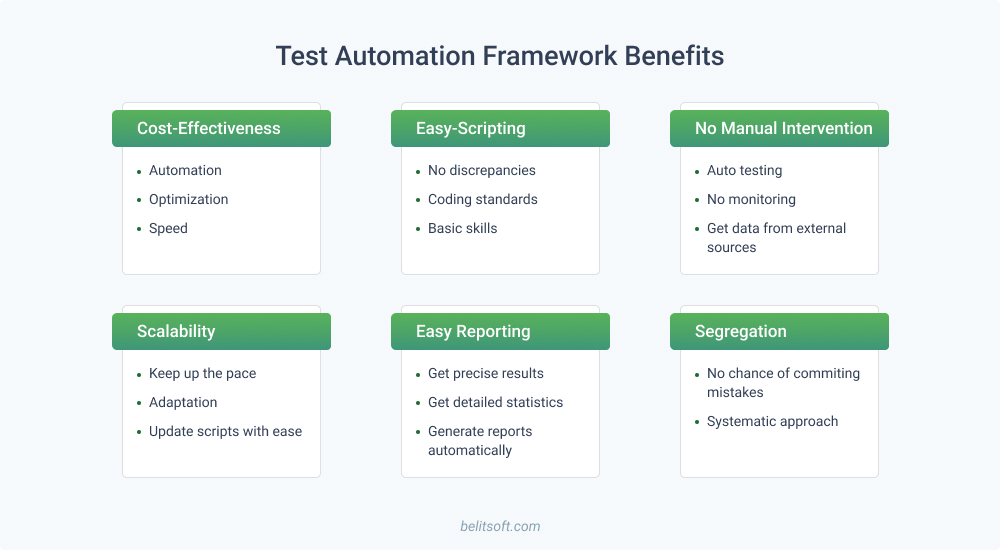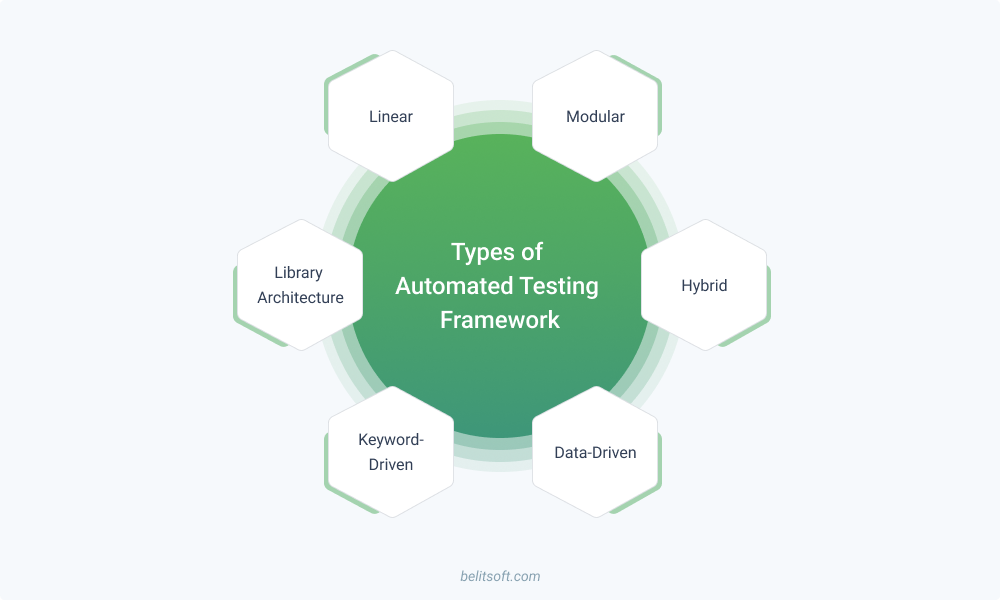Test automation is the key to reduced testing costs, faster time-to-market, and improved quality of an end product. So it’s no wonder that the trend towards test automation constantly grows, with most companies spending up to 49% of their QA budgets on automation. Even tech giants like IBM have patented their own reusable software testing automation framework to maximize testing efficiency. Keep on reading to find out the benefits of applying frameworks in test automation and the types of frameworks that will best fit your project.
Optimize your project with Belitsoft's tailored automation testing services. We help you identify the most efficient automated testing framework for your project and provide hands-on assistance in implementing it.
What is Test Automation Framework?
In a nutshell, a test automation framework is a set of guidelines for creating and designing test cases. These guidelines usually include various coding standards, data handling methods, object repositories, test results storage, and many other details.
The primary goals of applying a test automation framework are:
- to optimize testing processes,
- to speed up test creation & maintenance,
- to boost test reusability.
As a result, the testing team’s efficiency grows, developers get accurate reports, and business in general benefits from better quality without increasing expenses.
Benefits of a Test Automation Framework
According to the authoritative technology learning resource InformIT, a subsidiary of Pearson Education, the world's largest education company, the major benefits of test automation frameworks derive from automating the core testing processes:
- test data generation;
- test execution;
- test results analysis;
- plus, scalability is worth highlighting from a growing business perspective.

1. Automating test data generation
Effective test strategies always involve the acquisition and preparation of test data. If there is not enough input, functional & performance testing can suffer. Conversely, gathering rich test data increases testing quality and flexibility, and reduces maintenance efforts.
There are thousands of possible combinations, so manually gathering a production-size database can take several months. Besides, the human factor also makes the procedure error-prone. An automated approach speeds up the process and increases accuracy.
The team outlines the requirements, which is the longest part. Then a data generator is used within the framework. This tool models multiple input variants significantly faster than a QA engineer would do. Thus, you speed up the process, minimize errors, and eliminate the tedious part.
2. Automating test execution
Manual test execution is exceptionally time-consuming and error-prone. With a proper test automation framework, you can minimize manual intervention. This is what the regular testing process would look like:
- The QA engineer launches the script.
- The framework tests the software without human supervision.
- The results are saved in comprehensive & detailed reports.
As a result, the test engineer can focus on other tasks while the tool executes all the scripts.
It is also necessary to note that test automation frameworks simplify environment segregation and settings configuration. All these features combined reduce your test time. Sometimes, getting new results might even be a matter of seconds.
3. Test results analysis automation
A test automation framework includes a reporting mechanism to maintain test logs. The results are usually very detailed, including every bit of available information. This lets the QA engineer understand how, when, and what went wrong.
For example, the framework can show a comparison of the failed and original data with highlighted differences. Additionally, successful tests can be marked green, while processes with errors will be red. This speeds up output analysis and lets the tester focus on the main information.
4. Scalability
Most projects constantly grow, so it’s necessary that the testing tools keep up with the pace. Test frameworks can be adapted to support new features and the increased load.If required, QA engineers update the scripts to cover all innovations. The only requirement to keep the process simple is code consistency. This will help the team improve the scripts quickly and flawlessly.
Test automation frameworks are particularly strong in front-end testing. With the increasing complexity of web applications and the need for seamless user experiences across various platforms, automation frameworks provide a robust foundation for conducting comprehensive front-end tests. To learn more about front-end testing methodologies, including UI testing, compatibility testing, and performance testing, read our guide on the 'Types of Front-end Testing'.
If you are ready to reduce your testing costs, deliver your software faster, and improve its quality, consider outsourcing software testing to our experts with 16+ years of expertise in testing.
Types of Automated Testing Frameworks
There are six different types of frameworks used in software automation testing. Each comes with its own pros & cons, project compatibility, and architecture. Let’s have a closer look.

Linear Automation Framework
A linear framework does not require code writing. Instead, QA engineers record all the test steps like navigation or user input to perform an automatic playback. All steps are created sequentially. This type is most suitable for basic testing.
Advantages:
- The fastest way to generate test scripts;
- The sequential order makes it easy to understand results;
- Simple addition to existing workflows as most frameworks have preinstalled linear tools.
Disadvantages:
- No reusability, as the data from each test case is hardcoded in scripts;
- No scalability, as any changes require a complete rebuild of test cases.
Modular Based Testing Framework
A modular framework involves dividing a tested application into several units checked individually in an isolated environment. QA engineers write separate scripts for each part. Then, the scripts can be combined to build complex test structures covering the whole software.
Advantages:
- Changes in an application only affect separate modules, meaning you won’t have to rewrite all scripts;
- High reusability rate due to the possibility to apply scripts in different modules;
- Improved scalability to support new functionality.
Disadvantages:
- Requires some programming skills to build an efficient framework;
- Using multiple data sets is impossible because data remains hardcoded in scripts.
Library Architecture Testing Framework
A library architecture framework is a better version of a modular one. It identifies similar tasks in each script to group them by common goals. As a result, your tests are added to a library where they are sorted by functions.
Advantages:
- A high level of modularization leads to increased maintenance cost-efficiency and scalability;
- Better reusability due to the creation of libraries with common features that can be applied in other projects.
Disadvantages:
- Requires high-level technical expertise to modularize the tasks;
- The data remains hardcoded, meaning that any changes will require rewriting the scripts;
- The framework’s increased complexity requires more time to create a script.
Data-Driven Framework
A data-driven framework allows external data storage by separating it from the script logic. QA engineers mostly use this type when there is a need to test different data with the same logic. There is no hard coding. Thus, you can experiment with various data sets.
Advantages:
- You can execute tests with different data sets because there is no hardcoding;
- You can test various scenarios by only changing the input, reducing time expenses;
- The scripts can be adapted for any testing need.
Disadvantages:
- A high level of QA automation expertise is required to decouple the data and logic;
- Creating a data-driven framework is time-consuming, so it may delay the delivery pipeline.
Keyword-Driven Framework
A keyword-driven framework is a better version of the data-driven one. The data is still stored externally, but we also use a sheet with keywords associated with various actions. They help the team test an application’s GUI, as we may use labels like “click,” “clicklink,” “login,” and others to understand better the actions applied.
Advantages:
- You can create scripts that are independent of an application;
- Improved test categorization, flexibility, and reusability;
- Requires less maintenance in the long run, as all new keywords are automatically updated in test cases.
Disadvantages:
- It is the most complicated framework that is time-consuming and very complex;
- Requires high-level expertise in QA automation;
- You will have to update your keyword base constantly to keep up with the growing project.
Hybrid Testing Framework
A hybrid testing framework is a combination of the previous types. It has no specific rules. Combining different test automation frameworks allows you to get the best features that suit your product’s needs.
Advantages:
- You leverage the strengths and reduce the weaknesses of various frameworks;
- You get maximum code reusability to suit the project’s needs.
Disadvantages:
- Only an expert in QA automation can get the best out of a hybrid framework.
FAQ
What are automation testing frameworks?
An automation testing framework is a collection of tools and processes for creating & designing test cases. Some of the functions include libraries, test data generators, and reusable scripts.
What are the components of an automation framework?
The main components of a test automation framework are management tools, testing libraries, equipment, scripts, and qualified QA engineers. The set may vary depending on your project’s state.
What is a hybrid framework in test automation?
A hybrid framework is one that combines the features of different frameworks. For example, this could be a mix of data-driven and keyword-driven types to simplify the testing process and leverage all advantages.
Which framework is best for automation testing?
The best test automation frameworks are those that suit your project’s needs. However, multiple QA engineers point out Selenium, WebdriverIO, and Cypress as the most appropriate tools in the majority of cases. TestNG is the latest automation testing framework with multiple positive reviews.
How to Choose the Right Test Automation Framework
The real mastery in quality assurance is knowing which approach brings the maximum benefits for your product. Consider the following points to understand how to choose an automation framework.
1. Analyze the project requirements
You must consider your product’s possible environments, future development plans, and team bandwidth. These points will help you pick the required functionality from each framework. You might even come up with a combination of features to get the best results.
2. Research the market
You will need powerful business intelligence to understand which features suit your project best. Analyzing the market will help you determine potential errors, get a user-based view of the application, and find the right mix of framework features.
3. Discuss it with all stakeholders
A test automation framework is likely to be used across multiple team members. Therefore, your task is to gather their priorities and necessities to highlight the most important features for your framework. Based on this info, you should choose the most appropriate option.
4. Remember the business goals
The task of any test automation framework is to simplify the development process and facilitate bug searches. Your business might have a goal to complete tasks quicker at any cost, reduce financial expenses, or find a balanced and cost-efficient approach. Align the framework strategy with these objectives to make the right choice.
Rate this article
Recommended posts
Portfolio
Our Clients' Feedback






















.png)
.jpg)















Belitsoft has been the driving force behind several of our software development projects within the last few years. This company demonstrates high professionalism in their work approach. They have continuously proved to be ready to go the extra mile. We are very happy with Belitsoft, and in a position to strongly recommend them for software development and support as a most reliable and fully transparent partner focused on long term business relationships.
Global Head of Commercial Development L&D at Technicolor